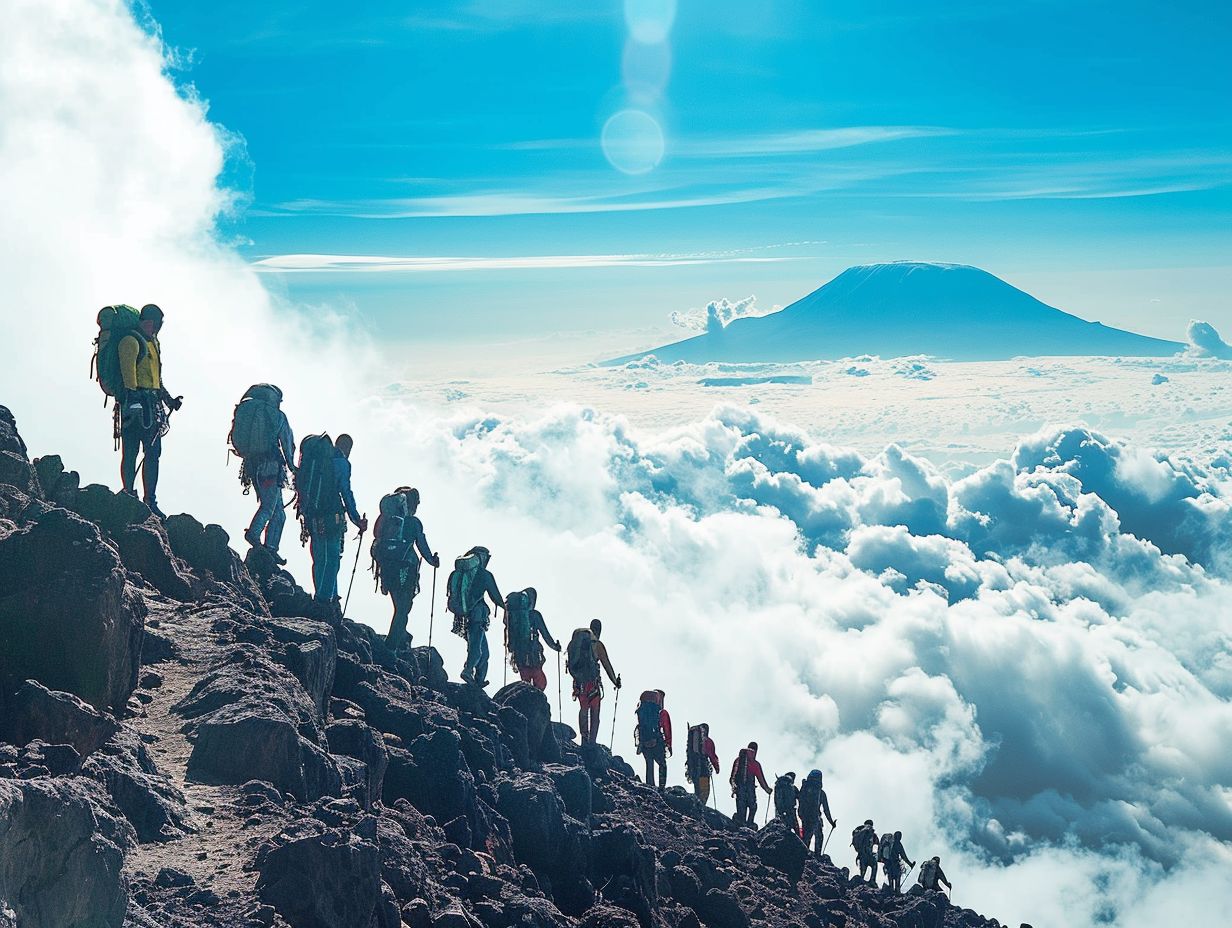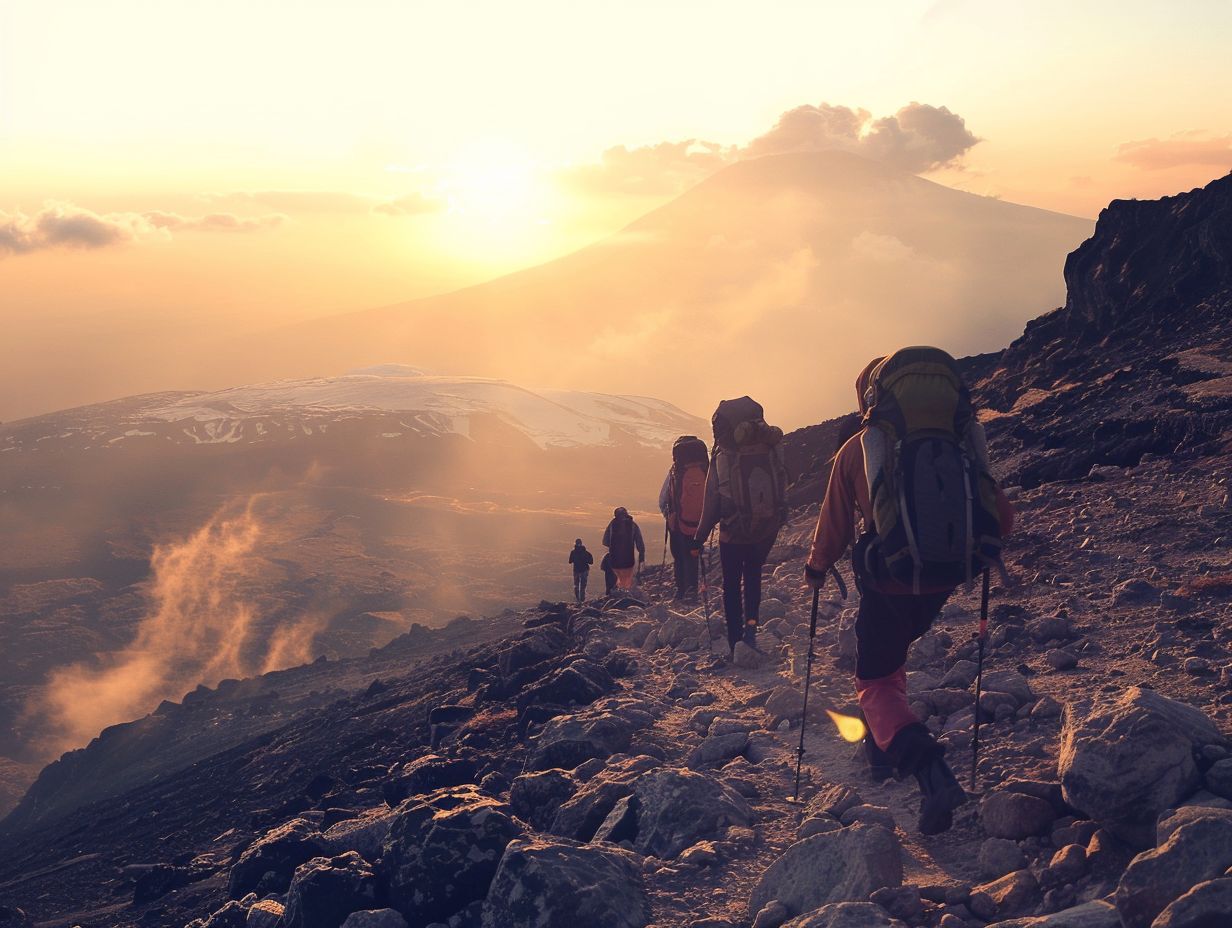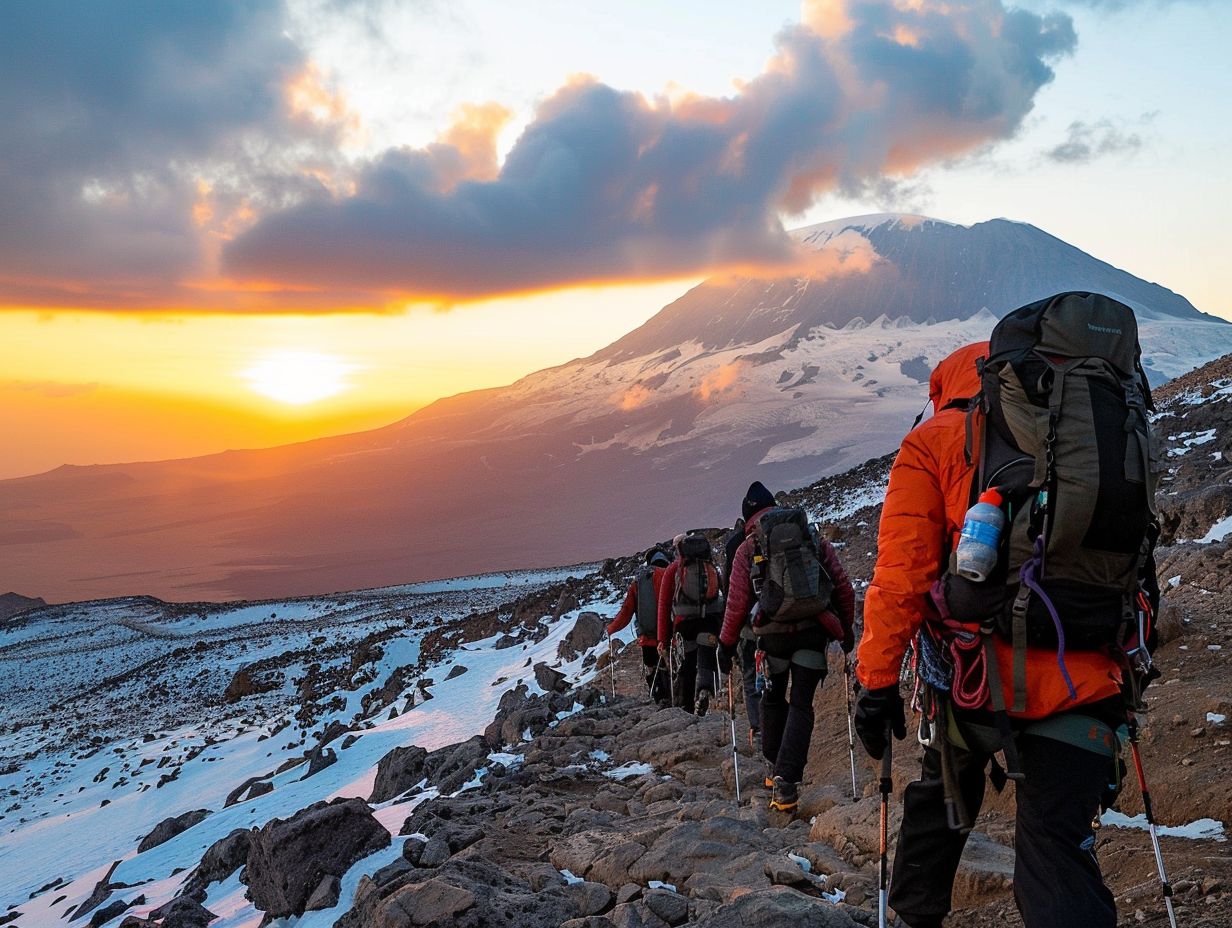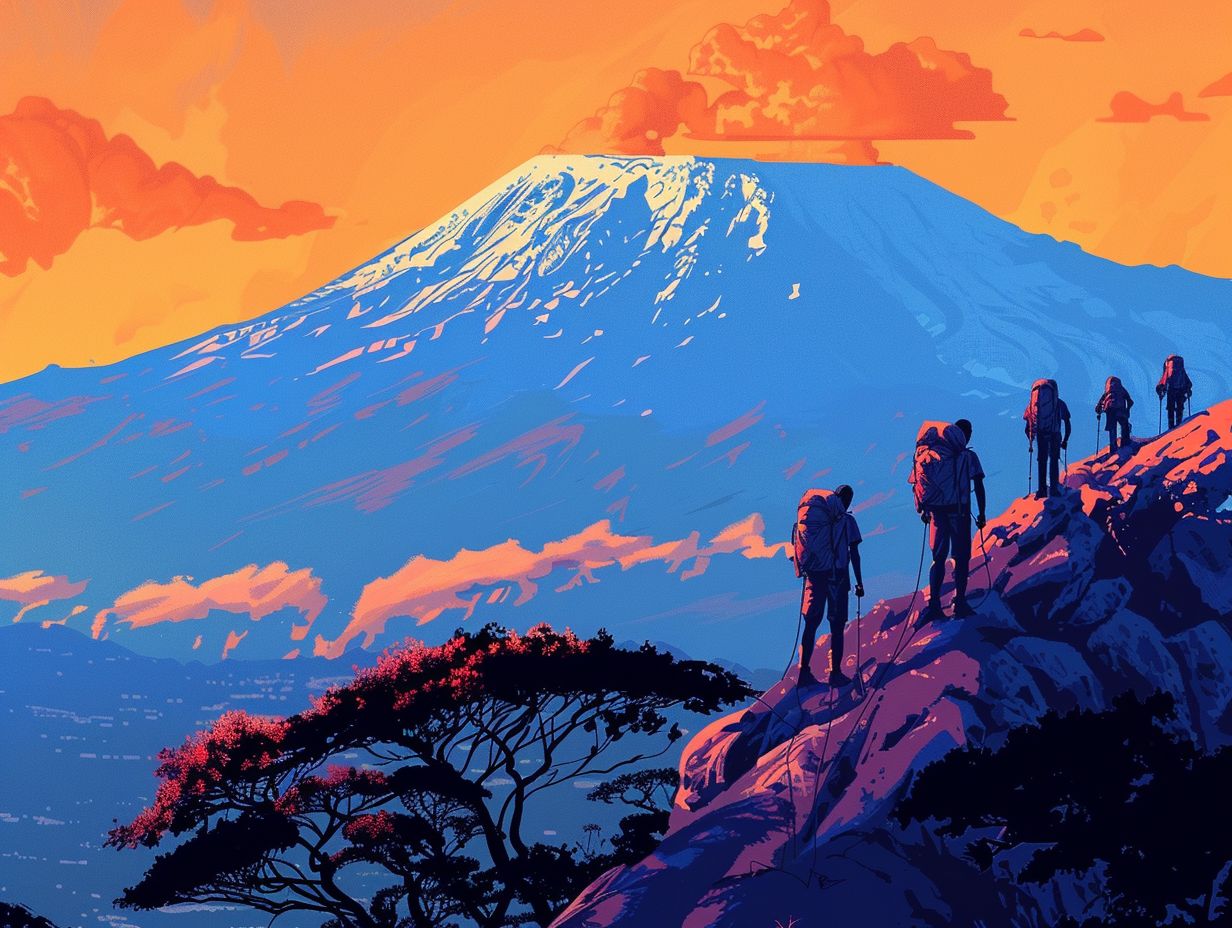
Considering climbing Mount Kilimanjaro but unsure about age restrictions and requirements?
We explore what it takes to conquer Africa’s highest peak from physical fitness and proper gear to age restrictions and risks for younger climbers.
Find out everything you need to know before embarking on this epic adventure. So, how old do you have to be to climb Kilimanjaro? Let’s find out together.
Key Takeaways:
- The minimum age to climb Kilimanjaro is 10 years old, but factors such as physical fitness and mental preparedness should be considered before allowing a child to attempt the climb.
- Age restrictions for group and private climbs may vary, with some tour companies setting a minimum age of 12 or 16 years old.
- Waiting until a certain age to climb Kilimanjaro can provide important benefits, such as physical and mental maturity, better preparation, and reduced risks and safety concerns.
Mount Kilimanjaro, located in Tanzania, is the highest peak in Africa and one of the most sought-after summits for climbers around the world.
Its majestic snow-capped summit rises to an impressive 5,895 meters (19,341 feet) above sea level, creating an awe-inspiring sight that attracts adventurers and nature enthusiasts alike.
Positioned near the border with Kenya, Kilimanjaro is a stratovolcano comprising three extinct volcanic cones: Kibo, Mawenzi, and Shira.
The mountain’s location within Kilimanjaro National Park offers diverse ecosystems from lush rainforests to alpine deserts, providing climbers with a unique and unforgettable trekking experience.
What Are The Requirements For Climbing Kilimanjaro?

Climbing Kilimanjaro requires proper training, experience and understanding of the health risks associated with high-altitude trekking.
Before embarking on this challenging adventure, it is crucial to have a good level of physical fitness and endurance. Climbers should gradually acclimate to the altitude to minimize the risk of altitude sickness.
A proper training regimen that includes cardiovascular exercises, strength training and hiking on varied terrain is essential to prepare for the demanding conditions on the mountain.
Understanding the symptoms of altitude sickness and knowing how to respond to them is paramount for a safe ascent. It is also advisable to undergo a medical check-up before starting the climb to assess any potential health risks.
Proper gear, including high-quality footwear, clothing, and protective equipment, is necessary to tackle the diverse climate and terrain on Kilimanjaro.
Physical Fitness
Physical fitness is paramount for a successful Kilimanjaro climb as the journey involves traversing high altitudes and challenging terrains.
Before embarking on the Kilimanjaro climb, climbers must undergo thorough medical checks to ensure their bodies are capable of handling the physical demands.
Training routines tailored to improve cardiovascular endurance, strength and flexibility are crucial in preparing for the expedition.
The ascent involves long hours of trekking at high altitudes, where the air is thin, making it essential to be in top physical condition to prevent altitude sickness.
Climbers must be prepared for drastic weather changes and rugged landscapes, requiring a high level of physical endurance and mental resilience.
Mental Preparation
Mental preparation is crucial for overcoming challenges during the Kilimanjaro climb and ensuring a successful summit experience.
As climbers embark on the arduous journey up Africa’s highest peak, the mental aspect often proves to be just as demanding as the physical exertion. To maintain mental resilience, climbers must adopt various strategies such as practicing mindfulness, visualization techniques, and positive self-talk.
These techniques help climbers stay focused, motivated and calm amidst the unpredictable conditions of the mountain.
The guides accompanying climbers play a vital role in providing not just physical support but also emotional encouragement. Their experience, knowledge and empathy can greatly contribute to boosting the climbers’ confidence and helping them navigate through tough mental challenges.
Proper Gear and Equipment
Having the right gear and equipment is essential for the safety and success of a Kilimanjaro climb, making it imperative to choose a reputable company for equipment and support.
Proper equipment ensures that climbers are adequately prepared for the varying conditions they will face on their journey up the majestic Kilimanjaro. From sturdy hiking boots to insulated jackets and high-quality sleeping bags, each piece of gear plays a crucial role in the climber’s comfort and safety.
Choosing the right trekking company is key, as they not only provide essential equipment but also offer experienced guides who are well-versed in the mountain’s challenges and can navigate potential risks effectively.
The selection of gear must be tailored to the individual needs and abilities of each climber to ensure a successful and enjoyable experience on the daunting slopes of Kilimanjaro.
What Is The Minimum Age To Climb Kilimanjaro?
The minimum age to climb Kilimanjaro is a topic of interest, with the record for the youngest climber drawing attention from the global climbing community.
Climbing Kilimanjaro is a challenging endeavor, demanding physical and mental preparation. For safety reasons the minimum age requirement to attempt this feat is generally set at 10 years old.
Despite this stipulation, some exceptional individuals have shattered age barriers, with Jordan Romero becoming the youngest known person to conquer Kilimanjaro at 10 years old in 2006.
When considering the age appropriateness of climbing Kilimanjaro, it’s crucial to take into account the physiological and psychological development of children. Pediatricians recommend that children should exhibit a certain level of physical maturity and emotional resilience before embarking on such a strenuous trek.
What Are The Factors To Consider When Determining Minimum Age?

When determining the minimum age for climbing Kilimanjaro, factors such as the health risks associated with high altitude and permission requirements for minors play a crucial role in decision-making.
While children may be adventurous and eager to conquer the mighty Kilimanjaro, their young bodies are more susceptible to altitude sickness and other health issues that can arise at such high elevations.
Therefore, it is essential to consider the physical readiness of young climbers and ensure they are adequately prepared for the challenges they may face.
Plus health concerns, many tour operators and governing bodies have specific rules regarding the participation of minors in such demanding expeditions. Obtaining parental consent, meeting age requirements, and providing appropriate supervision are standard practices to safeguard the well-being of young adventurers.
What Are The Age Restrictions For Climbing Kilimanjaro?
Kilimanjaro climbing tours often have age restrictions in place to ensure the safety and well-being of all participants during the challenging ascent.
It is important for climbers to be aware of these regulations before embarking on the journey up Africa’s highest peak. The age limitations set by tour operators vary but generally range from a minimum age of 10 to 18 years old, with some tours requiring participants to be at least 16 or 18 years old.
The safety measures enforced in Tanzania aim to reduce risks associated with high-altitude climbing, such as altitude sickness and physical exhaustion. By imposing age restrictions, tour operators and authorities prioritize the well-being of climbers and decrease the likelihood of accidents or health complications.
Age Restrictions for Group Climbs
Age restrictions for group climbs on Kilimanjaro are imposed to ensure cohesive team dynamics, proper supervision, and the safety of all climbers under the guidance of experienced guides.
These age restrictions vary depending on the route and tour operator but generally, participants must be at least 10 to 12 years old. This ensures that climbers have the physical stamina and maturity to handle the challenges of the ascent.
Younger climbers may struggle with the altitude, intense physical exertion and the mental resilience required for the climb. Therefore, having a minimum age requirement helps maintain a certain level of fitness and readiness.
Age Restrictions for Private Climbs
Private climbs on Kilimanjaro may have varying age restrictions based on parental consent, individual fitness levels, and the ability to adhere to safety protocols during the ascent.
While there is no strict age limit specified for climbing Kilimanjaro, most companies recommend a minimum age of 10-12 years old. This can vary depending on the tour operator and the route chosen. Parents or legal guardians are typically required to provide written consent for minors under a certain age.
Plus age considerations, climbers must undergo a fitness assessment to ensure they are physically prepared for the demanding journey ahead. The trek to the summit involves long hours of hiking at high altitudes, which can be challenging even for experienced hikers.
Safety protocols are paramount on Kilimanjaro, with guides emphasizing the importance of following instructions, staying hydrated, and being aware of altitude sickness symptoms. While age is a factor, personal fitness and a willingness to prioritize safety are crucial determinants of eligibility for private climbs on the iconic mountain.
What Are The Risks For Younger Climbers?
Younger climbers on Kilimanjaro face specific health risks related to altitude sickness, physical demands, and exposure to challenging environments such as glaciers.
Altitude sickness, also known as acute mountain sickness (AMS), can affect climbers of all ages but is particularly risky for younger individuals due to their developing bodies and potentially lower levels of physical fitness.
Symptoms of altitude sickness can range from mild headaches and nausea to more severe conditions like pulmonary edema or cerebral edema.
Plus altitude sickness, the physical challenges of climbing Kilimanjaro, including long days of trekking, steep ascents and carrying heavy gear, can put a strain on younger climbers’ bodies, increasing the risk of injuries and exhaustion.
The glaciers of Kilimanjaro, though beautiful, present their own hazards, such as crevasses, icefalls, and unpredictable weather conditions that can pose significant dangers to inexperienced climbers, especially the younger ones.
Altitude Sickness
Altitude sickness is a significant risk for climbers on Kilimanjaro, necessitating thorough medical checks and acclimatization strategies to mitigate potential health issues.
When ascending the majestic Mount Kilimanjaro, climbers must be mindful of the dangers posed by the decreasing oxygen levels at higher altitudes.
Symptoms of altitude sickness can range from mild headaches and nausea to more severe conditions like pulmonary edema or cerebral edema, which can be life-threatening. It is crucial for climbers to undergo medical evaluations before attempting the climb to assess their fitness and readiness for the journey.
Employing proper acclimatization techniques such as gradual ascent, staying hydrated and taking rest days at higher altitudes can help the body adjust to the changing conditions.
Physical Demands
The physical demands of climbing Kilimanjaro require optimal fitness levels, endurance, and mental fortitude, with expert guidance from companies like Duma Explorer ensuring climbers are prepared for the challenges.
Ascending the slopes of Africa’s tallest peak involves traversing various terrains battling high altitudes unpredictable weather conditions and the ever-looming risk of altitude sickness. Climbing Kilimanjaro is not merely a test of physical strength but also a mental and emotional journey, pushing individuals to their limits and beyond.
The trekking companies, such as Duma Explorer, play a pivotal role in the preparation process, offering comprehensive guidance on training regimes, equipment essentials, and acclimatization strategies.
Through their experienced guides and meticulous planning, climbers are equipped with the necessary skills and knowledge to tackle the arduous expedition ahead.
Safety Concerns

Safety concerns on Kilimanjaro encompass a range of precautions, including expert guidance from experienced guides, adherence to safety protocols and proactive measures to ensure the well-being of climbers.
Experienced guides play a critical role in navigating the challenges of Kilimanjaro, utilizing their extensive knowledge of the terrain and weather patterns to lead climbers safely to the summit.
These guides are not only skilled in mountaineering but also in recognizing early signs of altitude sickness a common threat on high-altitude treks. By closely monitoring climbers and adjusting the pace accordingly, guides help prevent altitude-related complications.
Climbers must diligently follow safety protocols, such as staying hydrated, pace control and proper gear usage. Neglecting these basics can escalate minor issues into serious emergencies underscoring the importance of discipline and caution in this demanding environment.
Aside from reactive measures, proactive strategies like regular communication with base camps, acclimatization breaks and thorough briefings before the ascent significantly enhance climbers’ safety.
These strategies preemptively address potential risks, augmenting the overall safety net for individuals embarking on the challenging journey up Kilimanjaro.
What Are The Benefits Of Waiting Until A Certain Age To Climb Kilimanjaro?
Waiting until a certain age to climb Kilimanjaro offers benefits such as enhanced physical and mental maturity, better planning and preparation, and increased success rates on the summit.
When individuals reach a certain level of maturity, they often have a better grasp of their physical capabilities and are more adept at managing mental challenges that come with the strenuous journey up Kilimanjaro.
This enhanced maturity can lead to a more measured approach, ensuring climbers are less likely to push their limits beyond what is safe and achievable.
With age comes experience, and seasoned climbers are more likely to engage in thorough planning and meticulous preparation before embarking on the expedition. This detailed approach can significantly enhance safety measures, increase comfort levels, and help in avoiding common mistakes that less experienced climbers might make.
Statistics suggest that climbers who wait until later years tend to have higher success rates in reaching the summit. The combination of mature decision-making, strategic planning, and physical readiness often results in a more fulfilling and triumphant Kilimanjaro climbing experience.
Physical and Mental Maturity
Physical and mental maturity play a vital role in preparing for a Kilimanjaro climb, with insights from pediatricians aiding in determining the appropriate age for such a challenging endeavor.
When considering the physical aspect, it’s crucial that climbers, regardless of age, engage in regular exercise to build stamina and endurance required to conquer the Kilimanjaro terrain. Mental readiness encompasses not just physical strength but also mental resilience, as climbers face altitude changes, unpredictable weather and the demands of multi-day hikes.
Pediatricians often stress the importance of age-appropriate physical development and psychological maturity in the decision-making process. They emphasize the need for young climbers to have fully developed cognitive abilities to assess risks and communicate effectively in high-stress situations.
Better Preparation and Planning
Delaying a Kilimanjaro climb allows for better preparation, meticulous planning, and focused fitness routines to increase the chances of a successful summit experience.
By taking your time to properly train and acquire essential skills, climbers can significantly enhance their endurance and overall performance on the challenging terrains of Mount Kilimanjaro.
Engaging in regular cardiovascular exercises, strength training and altitude simulation can be game-changers for acclimatization and stamina during the ascent.
Advance planning offers the opportunity to research the best routes, understand the unique climate variations, and gather essential gear and supplies to tackle Kilimanjaro’s unpredictable conditions effectively.
Preparing adequately can also help in preventing altitude sickness and ensuring a safer and more enjoyable journey overall.
Reduced Risks and Safety Concerns
Postponing a Kilimanjaro climb can lead to reduced risks, minimized safety concerns and a higher likelihood of successfully reaching the summit due to thorough preparation and risk mitigation strategies.
Delaying the climb allows climbers to acclimatize better, reducing the chances of altitude sickness and ensuring a smoother ascent. The extra time also enables individuals to undergo proper physical conditioning, enhancing their strength and endurance for the challenging trek ahead.
Postponing the expedition provides an opportunity to carefully assess weather conditions, select optimal climbing windows, and align with experienced guides for safer navigation.
What Are Some Alternatives For Younger Climbers?
For younger climbers unable to attempt Kilimanjaro, alternative options include tackling shorter routes or exploring hiking opportunities on nearby mountains to experience the thrill of high-altitude trekking.
Shorter routes like the Machame Route on Kilimanjaro or the Annapurna Base Camp trek in Nepal offer captivating yet less strenuous challenges. These routes provide a taste of high-altitude adventures without the extreme difficulty of scaling the highest peaks.
Local mountain hikes, such as those in the Rocky Mountains or the Alps, offer breathtaking views and elevation gains that can still provide a sense of accomplishment and connection to nature.
Shorter Routes
Shorter routes like the Machame Route or destinations like Crater Camp provide excellent alternatives for younger climbers seeking high-altitude experiences with less rigorous demands.
The Machame Route offers a more gradual ascent compared to other routes, allowing climbers to better acclimatize to the altitude, hence reducing the risk of altitude sickness. This makes it ideal for younger climbers or those looking for a less strenuous climb.
On the other hand, the breathtaking Crater Camp provides a unique experience that is both rewarding and achievable for climbers of varying skill levels. It offers stunning views of the crater and a chance to explore the surrounding area, making it an unforgettable adventure for those seeking a shorter but still challenging climb.
Hiking Nearby Mountains

Exploring nearby mountains through hiking expeditions offers younger climbers a gateway to outdoor adventures, allowing them to build skills and confidence under the supervision of experienced parents or guides.
One of the key advantages of engaging in such excursions is the physical and mental growth opportunities it presents. Mountain hiking fosters physical fitness, enhancing endurance, strength, and agility.
It also imparts valuable survival skills, navigation techniques, and an appreciation for nature’s wonders. Through these experiences, young adventurers learn to overcome challenges, cultivate resilience and develop a deep sense of accomplishment. Being in natural settings promotes mental well-being, reducing stress and fostering a sense of peace and tranquility.”
Frequently Asked Questions
How old do you have to be to climb Kilimanjaro?
The minimum age to climb Kilimanjaro is 10 years old. However, we recommend that climbers be at least 12 years old due to the physical and mental challenges of the climb.
Is there a maximum age limit for climbing Kilimanjaro?
There is no official maximum age limit for climbing Kilimanjaro. As long as you are physically fit and able to withstand the challenges of the climb, you can attempt it at any age.
Are there any age restrictions for climbing Kilimanjaro?
Apart from the minimum age requirement of 10 years old, there are no other age restrictions for climbing Kilimanjaro. However, we recommend that children under 18 years old be accompanied by an adult.
What is the recommended age range for climbing Kilimanjaro?
The recommended age range for climbing Kilimanjaro is between 12-65 years old. Younger children may not be physically or mentally prepared for the climb, while older individuals may have difficulty with the physical demands.
Is it safe for children to climb Kilimanjaro?
While Kilimanjaro is a challenging climb, it is generally safe for children as long as they are physically fit and accompanied by adults. Our experienced guides will also ensure the safety of all climbers during the trek.
Are there any age restrictions for climbing Kilimanjaro for charity?
No, there are no specific age restrictions for climbing Kilimanjaro for charity. However, keep in mind that the climb is physically and mentally demanding, so it is important to consider the age and capabilities of the individuals participating in the charity climb.